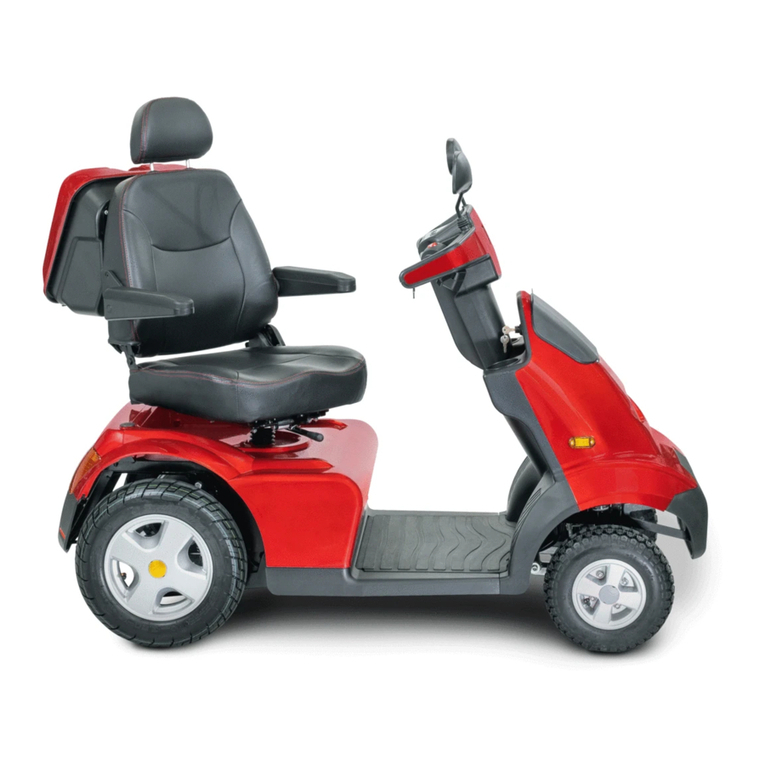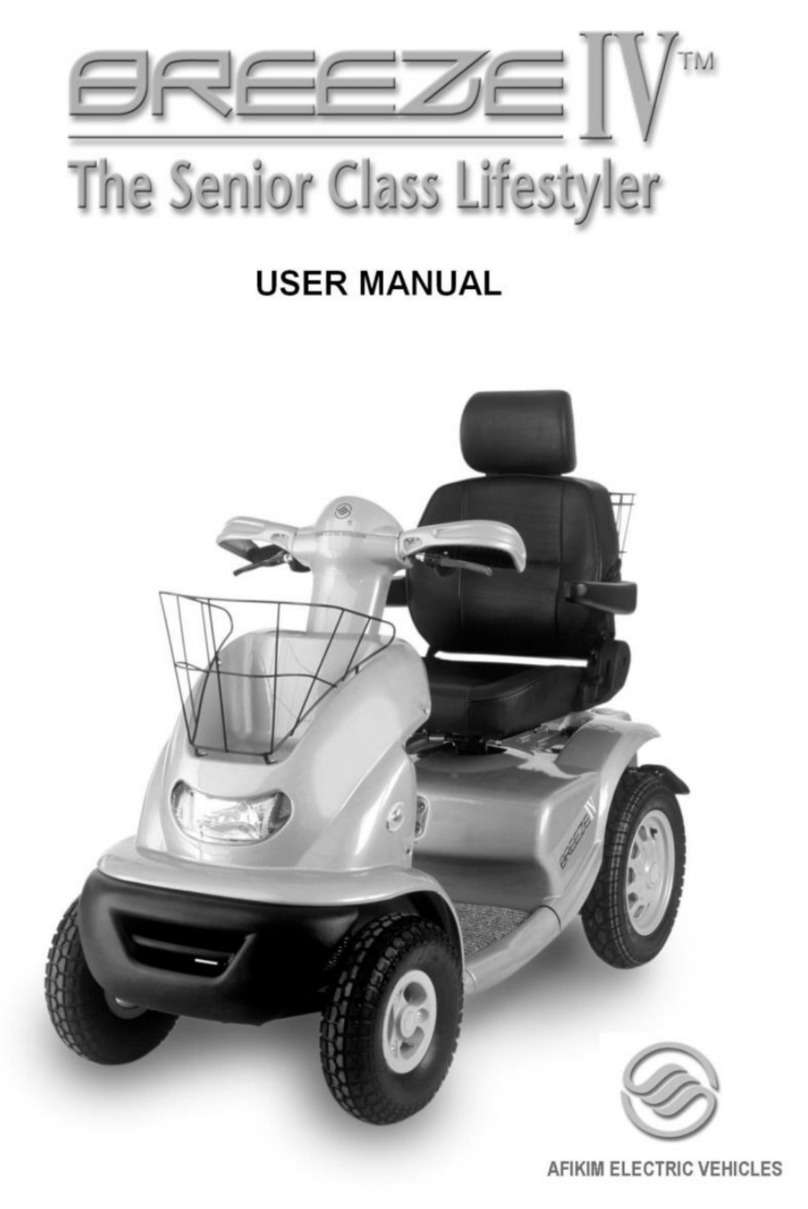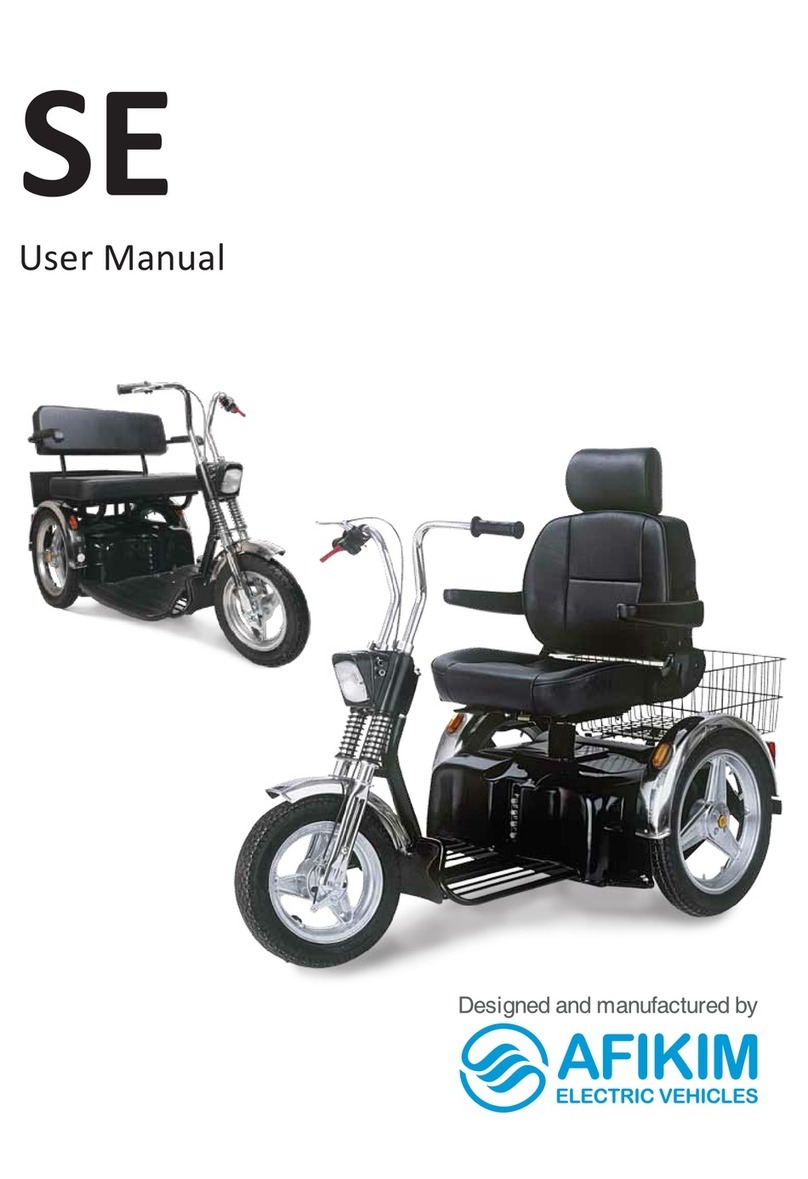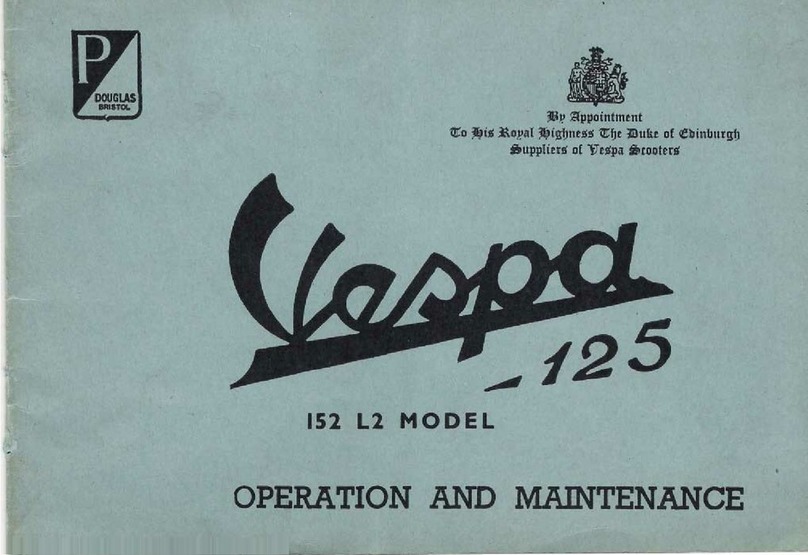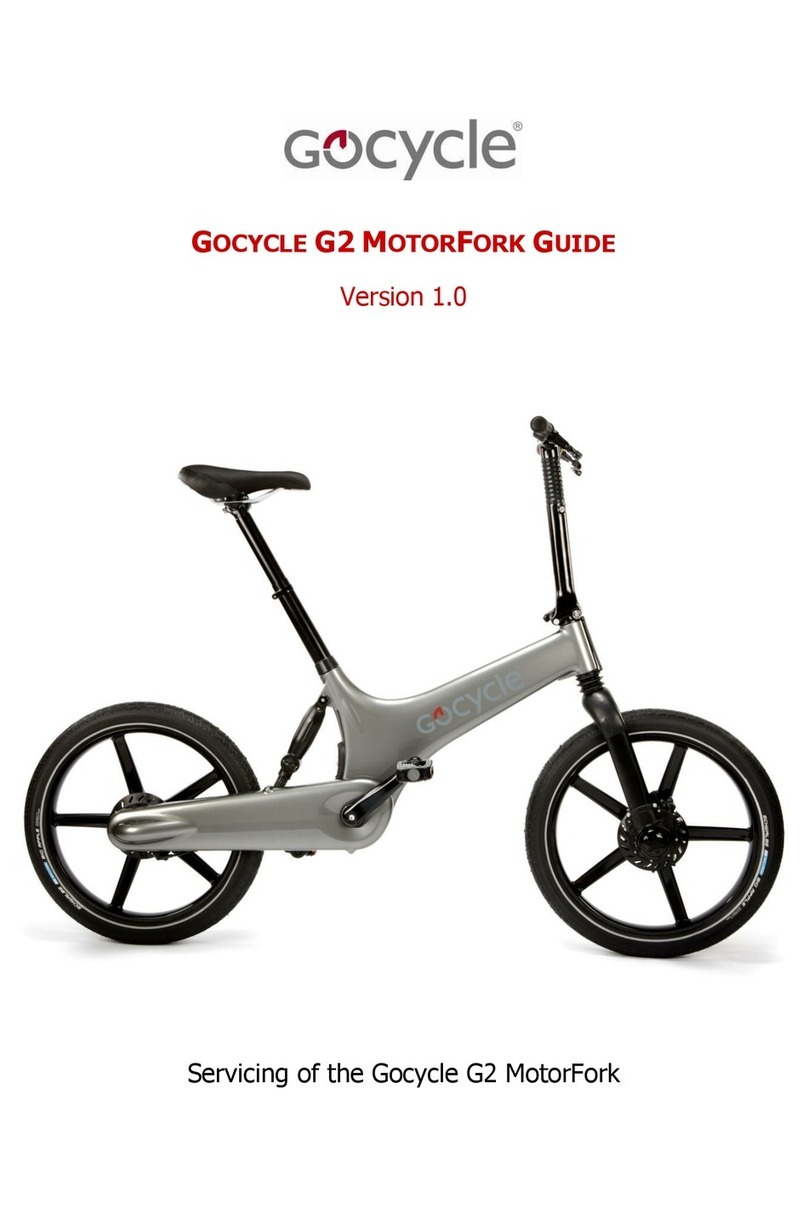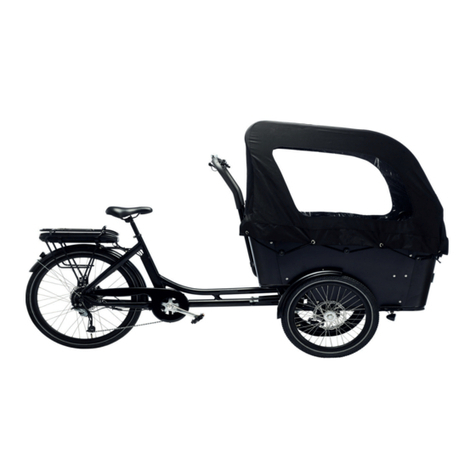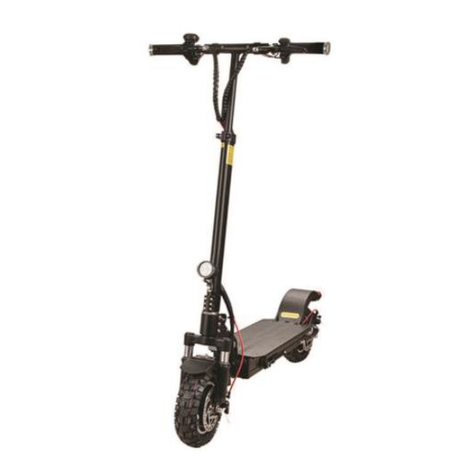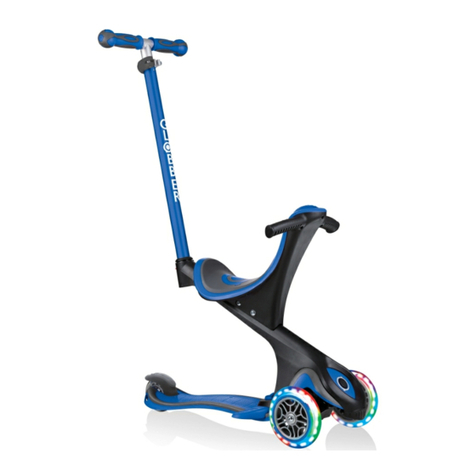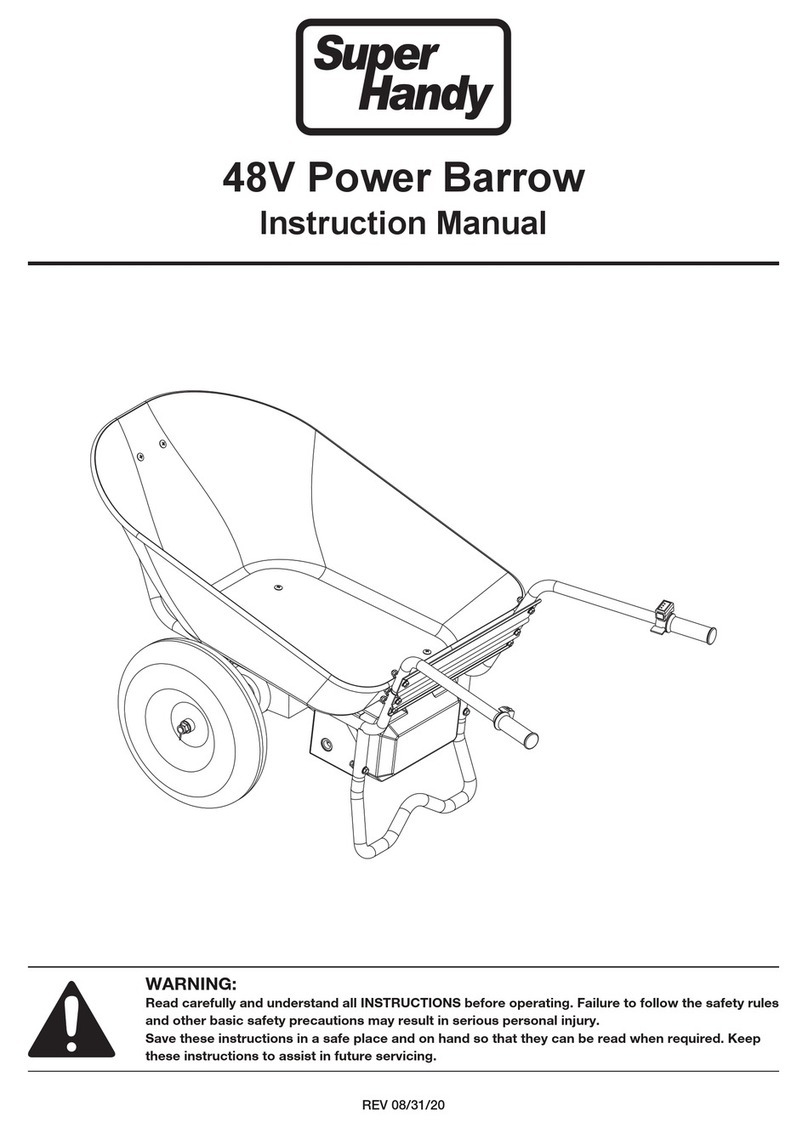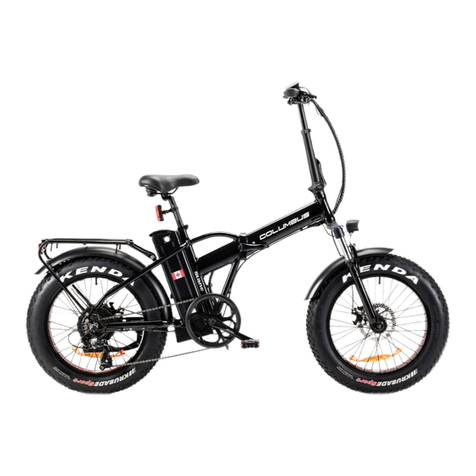Afikim Breeze-C User manual


2
WARNING
Read the User’s Manual carefully before operating the Breeze C.
If you do not fully understand any part of this Manual,
Please contact your dealer or any of our Service Center.
Read this manual step by step, as injury or damage may occur from misuse!
WARNING
Electromagnetic Interference (“EMI”) can cause powered vehicles to behave
erratically, which could be dangerous to the user.
For your safety and protection, it is IMPERATIVE that you take time to read
Chapter 6 (“EMI WARNING”) before operating the Breeze C.
Serial Number and Manufacturer’s data are fixed at the front area, on the plastic
Mud Guard cover on the metal Label of the Breeze C.
WARRANTY
AFIKIM ELECTRIC VEHICLES strives continuously to improve its products, their
quality and reliability in an incessant effort to ensure its customers’ satisfaction as
well as its place on the market.
Warranty for the Breeze C is subject to your local distributor's warranty.
CE CERTIFICATION
The Afikim Electric Vehicles Ref. Registration Number with the Competent
Authority (UK) Is: CA000292.
Our Authorized Representative with the Competent Authorities
is: MEDES LTD.POB 231
Stanmore, Middlesex, HA7 4YA, England
TEL/FAX: 0044-181-954-9964

3
CONTENTS
CHAPTER 1 –OVER VIEW OF THE Breeze C (MAIN FEATURES) 4
CHAPTER 2 –SAFETY Symbols for Breeze C 5
CHAPTER 2 –SAFETY INSTRUCTIONS for Breeze C 9
CHAPTER 3 –GENERAL DESCRIPTION OF THE Breeze C 18
CHAPTER 4 –ADJUSTMENTS INSTRUCTIONS 20
CHAPTER 5 –OPERATING INSTRUCTIONS 21
CHAPTER 6 –CHARGING 25
CHAPTER 7 –MAINTENANCE 26
CHAPTER 8 –TROUBLESHOOTING AND FAULT REPAIR 28
CHAPTER 9 –EMI WARNING 30
Appendix A –Specifications Sheet 31

4
CHAPTER 1 –OVER VIEW OF THE Breeze C (MAIN FEATURES)
Congratulations on choosing the Breeze C as your electrically powered Scooter.
The Breeze C is a scooter for Elderly and Disabled persons, Fun and Sport.
Scooter classification: Class B with according to EN12184.
The Breeze C is designed to a Maximum occupant mass of 150 Kg (352lbs).
The Breeze C is an indoor / outdoor scooter designed to work in normal environment
conditions from very cold areas of (-30ºC, -22ºF) and up to very hot areas up to (+45ºC,
+113ºF).
The Breeze C will operate in light splashing rain, but it is not recommended to use the
Breeze C at heavy rain or snow conditions for long period.
The Breeze C is easy to operate. The relatively large wheels enable driving on unpaved
roads, over medium rough terrain and to overcome obstacles as high as 4” (10 cm).
Pressure inflating of the tires can found in the technical specification table.
The Breeze C can climb slopes with angles and loads as detailed in the table in INCLINE
INFORMATION (page 12).
The Breeze C maximum safe slope is: (10.5%) 6º.
The braking system stops the Breeze C smoothly and a short distance after the Operating
Lever is released.
The Breeze C is equipped with both Front and Rear Shock Absorbers to give the user the
most comfort and soft driving, even when using the vehicle at medium rough terrain roads.
A standard hand brake is also provided for backup.
The Seat is spacious, comfortable and can be rotated for easy access (standard Seats)
and adjusted forward/reverse up/down for most fitness to the user.
All controls are conveniently located on the tiller and handlebar and are simple to operate.
Under normal conditions the Breeze C can travel approximately 30 km (20 miles) before
the batteries require recharging.
After reading through all this manual, before start using the Breeze C, do a visual check
through the all parts of the vehicle, to make sure that no external damage has been occur
to the vehicle while transportation. In any case you are not sure call your dealer and ask
for an explanation.
The Breeze C is developed to use maintenance free / sealed batteries only.
A Maintenance Manual is available for trained technicians.

5
CHAPTER 2 –SAFETY Symbols for Breeze C
WARNING! An authorized supplier or qualified technician must perform
the initial setup of this scooter and must perform all of the procedures
in this manual.
The symbols below are used throughout this owner's manual and on the scooter to
identify warnings and important information. It is very important for you to read
them and understand them completely.
WARNING! Indicates a potentially hazardous condition / situation.
Failure to follow designated procedures can cause either personal
injury, component damage, or malfunction.
On the product, this icon is represented as a black symbol
on a Triangle shape.
MANDATORY! These actions should be performed as specified. Failure
to perform mandatory actions can cause personal injury and/or
equipment damage. On the product, this icon is represented as a white
symbol on a dark background.
PROHIBITED! These actions are prohibited. These actions should not be
performed at any time or in any circumstances. Performing a prohibited
action can cause personal injury and/or equipment damage. On the
product, this icon is represented as a black symbol with a circle and
slash.
Please note and strictly adhere to the following Safety Instructions. Additional
Warnings and Notices are printed in this User’s Manual; it is imperative that
you read carefully all chapters of this Manual before operating the Breeze C.
It is also advisable to refresh your memory by re-reading this Manual
periodically.
Get acquainted with the Breeze C and its operational features before driving it.
Drive slowly (Place Speed Limit knob in mid speed position) until you get
used to the Breeze C, to its various functions, safety features, and to its
braking capabilities and limitations.
Watch carefully for pedestrians and drive your Breeze C accordingly.
In crowded areas always drive with the Speed Limit knob at half Speed.
Drive only where permitted according to all applicable local laws and
ordinances. Breeze C is 65 cm (25.5") width. Pay special attention not to hit
persons or any objects around the vehicle.
Never remove any of the Breeze C safety parts like Fenders, Plastic
Covers or Emergency Brake lever.
Never remove any of the Warnings Labels. If any of the Warning labels is
removed, got wear, painted etc. ask your dealer to supply
you a new labels.
Never put your hands, fingers, legs into any moving parts or under any
protection cover, since moving parts are under covers and heated surfaces
as well.
When adjusting/folding the seat back, armrest, seat sliders (forward /
reverse), tiller distance and as well when squeezing the speed lever or hand

6
brake, always be careful that your hands and fingers will not be trapped
between any of the moving parts.
Beware from trapping your fingers in the tiller mechanism, when adjusting the
tiller –Forward / Reverse.
Never load the Breeze C total loads (User weight and all other loads
combined) more than 150Kg (330lbs) or 135Kg (297lbs) depend on the
model including all the baskets.
The load in the Rear Basket should not exceed 8 kg (17.6 lbs).
The load in the Front Basket should no exceed 5 kg (11lbs).
The Breeze C is designed and built to carry ONE person only on the Single Seat model.
Never operate it with an additional person on board, not even a child.
Never inflate the Breeze C tires more than recommended on the tires
by the manufacturer.
Never use the Breeze C for climbing up or riding down stairs.
Never try to go an obstacle that is more than the maximum recommended
slope angle and curb climbing in the specification sheet.
When climbing an Obstacle drive always so that the Breeze C
Front is toward the obstacle.
If for any reason the Breeze C does not stop when you release the Operating
Lever, or stopped after longer distance than regular or higher than 3 meters
(level surface) , immediately use the Hand Brake to stop the Breeze C and
turn the Main Key Switch to “OFF”. Contact your dealer immediately.
Do not use the Breeze C neither at heavy rain or extreme humidity
conditions nor at temperatures below -30ºC (-22ºF) or above +45ºC
(+113ºF).
The seat weight is 15 Kg (33lbs). Each battery weight 14 Kg (31lbs) and
more. Be careful when lifting the seat and the batteries.
See instruction for lifting in Chapter 3: Maintenance and Chapter 5: Repair
and troubleshooting. Keep lifting using your Knees/legs and not loading your
Back.
If the Breeze C is involved in any kind of an accidents that parts are
damaged, it is necessary to check the vehicle by qualified technician
before go on using it.
Batteries contain lead and acid which is very corrosive. Batteries
should be disposed only to a proper disposal.
When driving always make sure, that the backrest is in most upright
position.

7
Use Lead Acid maintenance free / sealed batteries only.
WARNING !!! Special care must be taken to prevent children from operating
the Breeze C.
Do not allow unsupervised children to play near the Breeze C scooter while
the batteries are charging.
Always drive carefully, adjust the speed according the limitation of the road.
Instability problem can arise when performing turns at high speed. Before
making sharp turns, reduce the Breeze C speed to minimum to prevent side
roll-over.
The Breeze C is able to go up slope higher than the recommended safe
slope. Do not drive on slopes you are not sure about their angle. However
drive very slowly and prevent side driving on such slopes.
Before start driving make sure your emergency brake is tight and operate
properly.
Do not release the Manual or Electrical Release Lever of the
Electromagnetic Brake when the Breeze C is on a slope.
When on any sort of an incline or decline, never place the
Breeze C scooter in freewheel mode while seated on it or
standing next to it.
The lights of the Breeze C should be on when visibility is restricted,
either by day or by night.
Since your seat upholstery is Fire resistant, do not cover or replace
with other upholstery than an original one.
When removing the Batteries cover be careful from hot parts. The Motor,
Transaxle, EMB, Electronic cards and electronic controller might be warmed,
Do not touch them before you make sure about their temperature.
Pay attention that your fingers will not be pressed between the levers
and the Rubber Grip.
Do not use a cell phone, walkie/talkie, laptop, or other radio transmitter while
operating the Breeze C.
Removal of grounding prong can create electrical hazard. If necessary,
properly install an approved 3-pronged adapter to an electrical outlet having
2-pronged plug access.

8
Do not connect an extension cord to the AC/DC converter or the
battery charger.
Keep tools and other metal objects away from battery terminals. Contact
with tools can cause electrical shock.
Do not sit on the mobility product when it is being used in connection with
any type of lift/elevation product.
Explosive conditions exist!
Disposal and recycling-Contact your authorized Provider for information on
proper disposal of your Breeze C product and its packaging.
Wear safety glosses.
Contains Lead.
Battery charger for indoor use only.
Flammable material. Do not expose to open flame.
At the rear of the Breeze C you can find the electromagnetic brake
manual release lever. When using this lever be careful not to touch
the internal surface of the motor, they could be very hot and cause
injure. See the warning label at the rear of the scooter near the
lever.

9
CHAPTER 2 –SAFETY INSTRUCTIONS for Breeze C
GENERAL MANDATORY! Do not operate your new Breeze C scooter for the first time
without completely reading and understanding this owner’s manual.
Your Breeze C is a state-of-the-art life-enhancement device designed to
increase mobility. We provide you an extensive variety of products to best fit
the individual needs of the user. Please be aware that the final selection and
purchasing decision regarding the type of Breeze C scooter to be used is the responsibility
of the user who is capable of making such a decision and his/her healthcare professional
(i.e., medical doctor, physical therapist, etc.).
The contents of this manual are based on the expectation that a mobility device expert has
properly fitted the Breeze C scooter to the user and has assisted the prescribing
healthcare professional and/or the authorized Provider in the instruction process for the
use of the product.
There are certain situations, including some medical conditions, where the user will need
to practice operating the Breeze C scooter in the presence of a trained attendant. A
trained attendant can be defined as a family member or care professional specially trained
in assisting a user in various daily living activities.
As you begin using your Breeze C scooter during daily activities, you will probably
encounter situations in which you will need some practice. Simply take your time and you
will soon be in full and confident control as you maneuver through doorways, on and off
elevators, up and down ramps, and over moderate terrain.
Below are some precautions, tips, and other safety considerations that will help the you
become accustomed to operating the Breeze C scooter safely.
MODIFICATIONS
We have designed and engineered your Breeze C Scooter to provide
maximum mobility and utility. However, under no circumstances should you
modify, add, remove, or disable any feature, part, or function of your Breeze
CScooter.
WARNING! Do not modify your Breeze C Scooter in any way not authorized
by the manufacturer. Do not use accessories if they have not been tested or approved by
the manufacturer.
REMOVABLE PARTS
WARNING! Do not attempt to lift or move your Breeze C Scooter by any of
its removable parts , including the armrests, seat, or shroud.
PRE-RIDE SAFETY CHECK
Get to know the feel of your Breeze C Scooter and its capabilities. We
recommends that you perform a safety check before each use to make sure
your Breeze C Scooter operates smoothly and safely.
Perform the following inspections prior to using your scooter:
Check for proper tire inflation. Maintain but do not exceed the psi/bar/kPa air
pressure rating indicated on each tire if equipped with pneumatic tires.
Check all electrical connections. Make sure they are tight and not corroded.
Check all harness connections. Make sure they are secured properly.
Check the brakes.
Check battery charge.
If you discover a problem, contact your authorized Breeze C Provider for assistance.

10
TIRE INFLATION
Your Breeze C scooter is equipped with pneumatic tires, you should check or
have the air pressure checked at least once a week. Proper inflation
pressures will prolong the life of your tires and help ensure the smooth
operation of your Breeze C scooter.
WARNING! It is critically important that the psi/bar/kPa air pressure indicated
on each tire be maintained in pneumatic tires at all times. Do not underinflate or overinflate
your tires. Low pressure may result in loss of control, and overinflated tires may burst.
Failure to maintain the psi/bar/kPa air pressure rating indicated on pneumatic tires at all
times may result in tire and/or wheel failure.
WARNING! Inflate your scooter tires from a regulated air source with an available
pressure gauge. Inflating your tires from an unregulated air source could overinflate
them, resulting in a burst tire.
NOTE: If the tires on your Breeze C scooter marked with psi rating only, use the
following conversion formulas to find the bar or kPa rating:
bar = psi x 0.06895 , kPa = psi x 6.89476.
WEIGHT LIMITATIONS
Your scooter is rated for a maximum weight capacity. Refer to the
specifications table for information. See appendix A.
MANDATORY! Stay within the specified weight capacity for your Breeze C
scooter. Exceeding the weight capacity voids your warranty. We will not be
held responsible for injuries and / or property damage resulting from failure to
observe weight limitations.
WARNING! Do not carry passengers on your scooter. Carrying passengers on your
Breeze C scooter may affect instable conditions.
INCLINE INFORMATION
More and more buildings have ramps with specified degrees of inclination,
designed for easy and safe access. Some ramps may have turning
switchbacks (180-degree turns) that require you to have good cornering skills
on your Breeze C scooter.
Proceed with extreme caution as you approach the downgrade of a ramp or incline.
Take wide swings with your Breeze C scooter around any tight corners. If you do
that, the scooter’s rear wheels will follow a wide arc, do not cut the corner short, and do
not bump into or get hung up on any railing corners.
When driving down a ramp, keep the Breeze C scooter’s speed adjustment set to
the slowest speed setting to ensure a safely controlled descent.
Avoid sudden stops and starts.
Follow the next figure A according your scooter speed.

11
Breeze C speed 15 km/hr:
Breeze C speed 12 km/hr:
Breeze C speed 10 km/hr:
IFigure A. Maximum Recommended Incline Angle
When climbing an incline, try to keep your Breeze C scooter moving. If you must stop,
start up again slowly, and then accelerate cautiously. When driving down an incline, do so
by setting the speed adjustment dial to the slowest setting and driving in the forward
direction only. If your Breeze C scooter starts to move down the incline faster than you
anticipated or desired, allow it to come to a complete stop by releasing the throttle control
lever. Then push the throttle control lever forward slightly to ensure a safely controlled
descent.
WARNING! When on any sort of an incline or decline, never place the Breeze C
Scooter in freewheel mode while seated on it or standing next to it.
WARNING! When climbing an incline, do not zigzag or drive at an angle up the face
of the incline. Drive your Breeze C Scooter straight up the incline. This greatly reduces the
possibility of a tip or a fall. Always exercise extreme caution when negotiating an incline.
WARNING! Do not drive your Breeze C Scooter across the side of an incline or diagonally
up or down an incline; do not stop, if possible, while driving up or down an incline.
WARNING! You should not travel up or down a potentially hazardous
incline (i.e., areas covered with snow, ice, cut grass, or wet leaves).
WARNING!
Even though your Breeze C Scooter is capable of climbing slopes
greater than those illustrated in figure A , do not, under any
circumstances, exceed the incline guidelines or any other specifications
presented in this manual. Doing so could cause instability in your Breeze
Cscooter.
Handicap public accesses ramps are not subject to government regulation in all countries,
and therefore do not necessarily share the same standard percent of slope. Other inclines
may be natural or, if man-made, are not designed specifically for Breeze C Scooters.

12
Figure A illustrates your Breeze C Scooter’s stability and its ability to climb grades under
various weight loads and under controlled testing conditions.
These tests were conducted with the Breeze C Scooter’s seat in the highest position and
adjusted rearward on the seat base to its farthest rearward position. Use this information
as a guideline. Your Breeze C Scooter’s ability to travel up inclines is affected by your
weight, your Breeze C Scooter’s speed, your angle of approach to the incline, and your
Breeze C scooter setup.
WARNING! Any attempt to climb or descend a slope steeper than what is shown in figure-
A may put your Breeze C scooter in an unstable position and cause it to tip.
WARNING! Never carry an oxygen tank weighing more than 15 lbs (6.8 kg). Never fill the
front or rear basket with contents exceeding 5 Kg (11 lbs) in the front and 8 Kg
(17.6lbs) in the rear basket.
Figure B. Normal Driving Position Figure C. Increased Stability Drive Position
When you approach an incline, it is best to lean forward. See Figures B and C. This shifts
the center of gravity of you and your Breeze C Scooter toward the front of the Breeze C
scooter for improved stability.
NOTE: When negotiating ramps, if the throttle control lever is released while moving
forward, the powered Breeze C Scooter may "rollback" approximately 1 foot (30.5
cm) before the brake engages. If the throttle control lever is released while moving
in reverse, the powered Breeze C scooter may "rollback" approximately 3 feet (one
meter) before the brake engages.
CORNERING INFORMATION
Excessively high cornering speeds can create the possibility of tipping. Factors which
affect the possibility of tipping include, but are not limited to, cornering speed, steering
angle (how sharply you are turning), uneven road surfaces, inclined road surfaces, riding
from an area of low traction to an area of high traction (such as passing from a grassy area
to a paved area –especially at high speed while turning), and abrupt directional changes.
High cornering speeds are not recommended. If you feel that you may tip over in a corner,
reduce your speed and steering angle (i.e., lessen the sharpness of the turn) to prevent
your Breeze C scooter from tipping.
WARNING! When cornering sharply, reduce your speed and maintain a stable center of
gravity. When using your Breeze C scooter at higher speeds, do not corner sharply. This
greatly reduces the possibility of a tip or fall. Always exercise your senses when cornering.
BRAKING INFORMATION
Your Breeze C scooter is equipped with these powerful brake systems:
Regenerative: Uses electricity to rapidly slow the vehicle when the throttle control
lever returns to the centre/stop position.
Park Brake: Activates automatically after regenerative braking slows the vehicle to
near stop, or when power is removed from the system for any reason.

13
OUTDOOR DRIVING SURFACES
Your Breeze C scooter is designed to provide optimum stability under normal
driving conditions- dry, level surfaces composed of concrete, blacktop, or asphalt.
However, We recognizes that there will be times when you will encounter other surface
types. For this reason, your Breeze C Scooter is designed to perform admirably on packed
soil, grass, and gravel. Feel free to use your Breeze C Scooter safely on lawns and in
park areas.
Reduce your Breeze C Scooter’s speed when driving on uneven terrain and/or soft
surfaces.
Avoid tall grass that can become tangled in the running gear.
Avoid loosely packed gravel and sand.
If you feel unsure about a driving surface, avoid that surface.
PUBLIC STREETS AND ROADWAYS
WARNING! You should not operate your Breeze C scooter on public streets and
roadways.
Be aware that it may be difficult for traffic to see you when you are seated on your
Breeze C Scooter. Obey all local pedestrian traffic rules. Wait until your path is clear of
traffic, and then proceed with extreme caution.
STATIONARY OBSTACLES (STEPS, CURBS, ETC.)
WARNING! Do not drive near raised surfaces, unprotected ledges, and/or
drop-offs (curbs, porches, stairs, etc.).
WARNING! Do not attempt to have your Breeze C Scooter climb or descend
an obstacle that is inordinately high.
WARNING! Do not attempt to have your Breeze C Scooter proceed
backward down any step, curb, or other obstacle. This may cause the
Breeze C Scooter to tip.
WARNING! Be sure your Breeze C Scooter is traveling perpendicular to any curb you may
be required to ascend or descend.
WARNING! Do not attempt to negotiate a curb that has a height greater than 10 cm (4").
INCLEMENT WEATHER PRECAUTIONS
Exposure of your Breeze C Scooter to inclement weather conditions should be avoided
whenever possible.
If suddenly caught up in rain, snow, severe cold or heat while operating your Breeze C
Scooter, proceed to shelter at the earliest opportunity. Thoroughly dry your Breeze C
Scooter before storing, charging, or operating your Breeze C Scooter.
PROHIBITED! Operating in rain, snow, salt, mist/spray conditions, and on icy slippery
surfaces can have an adverse affect on the electrical system. Maintain and store your
Breeze C Scooter in a dry and clean condition.
WARNING! Prolonged exposure to hot or cold conditions may affect the temperature of
upholstered and non-upholstered items on the Breeze C Scooter, possibly resulting in skin
irritation. Exercise caution when using your Breeze C Scooter in extremely hot or cold
conditions or when exposing your Breeze C Scooter to direct sunlight for prolonged
periods of time.

14
FREEWHEEL MODE Your Breeze C Scooter is equipped with a manual freewheel
lever that, when pushed Upward, allows the Breeze C scooter
to be pushed. For more information about how to place your
Breeze C scooter into and out of freewheel mode, see 3.
“General description of your Breeze C scooter.”
WARNING! When your Breeze C scooter is in freewheel mode,
the braking system is disengaged.
Disengage the drive motors only on a level surface.
Ensure the key is removed from the key switch.
Stand beside the Breeze C Scooter to engage or disengage freewheel mode. Never
seat on a Breeze C Scooter to do this.
After you have finished pushing your Breeze C Scooter, always return it to the drive
mode to lock the brakes.
An added feature built into the Breeze C Scooter is “push-too-fast” protection which
safeguards the Breeze C scooter against gaining excessive speed while in freewheel
mode.
“Push-too-fast” operates differently depending on which of two conditions exists:
If the key is switched “off” while in freewheel mode, the Breeze C scooter’s controller
activates regenerative braking when the Breeze C scooter is pushed faster than a
maximum threshold which has been preprogrammed. In this case, the controller is
acting as a speed governor.
If the key is switched “on” while in freewheel mode, you will encounter considerable
resistance at any speed. This prevents the Breeze C scooter from gaining unwanted
momentum should the manual freewheel lever inadvertently be released while driving
the Breeze C scooter.
When using this lever be careful not to touch the internal surface of the motor, they
could be very hot and cause injure. See the warning label at the rear of the scooter
near the lever.
STAIRS AND ESCALATORS
Breeze C scooters are not designed to travel up or down stairs or escalators.
Always use an elevator.
WARNING! Do not use your Breeze C scooter to negotiate steps or escalators.
DOORS
Determine if the door opens toward or away from you.
Use your hand to turn the knob or push the handle or push-bar.
Drive your Breeze C Scooter gently and slowly forward to push the door open. Or
drive your Breeze C Scooter gently and slowly rearwards to pull the door open.
S A F E T Y
ELEVATORS
Modern elevators have a door edge safety mechanism that, when pushed, reopens the
door(s).
If you are in the doorway of an elevator when the door(s) begin to close, push on the
rubber door edge or allow the rubber door edge to contact the Breeze C scooter and
the door will reopen.
Use care that pocketbooks, packages, or Breeze C Scooter accessories do not
become caught in elevator doors.
NOTE: Sometimes turning with your Breeze C Scooter may be difficult to maneuver in
elevators and building entrances. Use caution when attempting to turn or maneuver your
Breeze C Scooter in small spaces, and avoid areas that might pose a problem.

15
LIFT/ELEVATION PRODUCTS
If you will be traveling with your Breeze C scooter, you may find it necessary to use a
lift/elevation product to aid in transportation. We recommends that you closely review the
instructions, specifications, and safety information set forth by the manufacturer of the
lift/elevation product before using that product.
WARNING! Never sit on your Breeze C Scooter when it is being used in connection with
any type of lift/elevation product. Your Breeze C Scooter was not designed with such use
in mind and any damage or injury incurred from such use is not the responsibility of us.
BATTERIES (see also replacing batteries page #31)
In addition to following the warnings below, be sure to comply with all other
battery handling information.
MANDATORY! Battery posts, terminals, and related accessories contain lead
and lead compounds. Wear goggles and gloves when handling batteries and
wash hands after handling.
WARNING! Scooter batteries are heavy. See specifications table. If you are unable to lift
that much weight, be sure to get help. Use proper lifting techniques and avoid lifting
beyond your capacity.
WARNING! Always protect the batteries from freezing and never charge a frozen battery.
WARNING! Connect the battery harnesses in the proper manner. RED (+) cables must be
connected to positive (+) battery terminals/posts. BLACK (-) cables must be connected to
negative (-) battery terminals/posts. REPLACE cables immediately if damaged. Protective
caps must be installed over all battery terminals.
NOTE: If you encounter a damaged or cracked battery, immediately enclose it in a plastic
bag and contact your local waste disposal agency or authorized Breeze C Provider for
instructions on disposal and battery recycling, which is our recommended course of action.
MOTOR VEHICLE TRANSPORT
The manufacturer recommends that you do not remain seated in your Breeze C scooter
while traveling in a motor vehicle. The Breeze C scooter should be stowed in the trunk of a
car or in the back of a truck or van with the batteries removed and properly secured. In
addition, all removable Breeze C scooter parts, including the armrests, seat, and shroud
should be removed and/or properly secured during motor vehicle transport.
WARNING! Although your Breeze C scooter may be equipped with a positioning belt, this
belt is not designed to provide restraint during motor vehicle transport. Anyone travelling in
a motor vehicle should be properly secured in the motor vehicle seat with safety belts
fastened securely.
WARNING! Do not sit on your Breeze C scooter while it is in a moving vehicle.
WARNING! Always be sure your Breeze C scooter and its batteries are properly secured
when it is being transported. Batteries should be secured in an upright position, and
protective caps should be installed on the battery terminals. Batteries should not be
transported with any flammable or combustible items.
POSITIONING BELTS (Optional)
Although your Breeze C scooter may be equipped with a positioning belt (optional), this
belt is not designed to provide proper restraint during motor vehicle transport. Anyone
traveling in a motor vehicle should be properly secured in the motor vehicle seat with
safety belts fastened securely.
WARNING! Do not sit on your Breeze C scooter while it is in a moving vehicle.
WARNING! Ensure your Breeze C scooter and its batteries are properly secured when
being transported.

16
PREVENTING UNINTENDED MOVEMENT
WARNING! If you anticipate being seated in a stationary position for an extended period of
time, turn off the power. This will prevent unexpected motion from inadvertent throttle
control lever contact.
GETTING ONTO AND OFF OF YOUR Breeze C SCOOTER
Getting onto and off of your Breeze C scooter requires a good sense of
balance. Please observe the following safety tips when getting onto and off
of your Breeze C scooter:
Remove the key from the key switch.
Ensure that your Breeze C scooter is not in freewheel mode.
See 3- “General description of the Breeze C scooter.”
Ensure that the seat is secured into place.
Pivot the armrests up to make getting onto and off of the Breeze C scooter easier.
WARNING! Position yourself as far back as possible in the Breeze C scooter seat to
prevent the Breeze C scooter from tipping and causing injury.
WARNING! Avoid putting all of your weight on the Breeze C scooter armrests and do not
use the armrests for weight bearing purposes, such as transfers. Such use may cause the
Breeze C scooter to tip, resulting in a fall from the Breeze C scooter and/or personal
injury.
WARNING! Avoid putting all of your weight on the floorboard. Such use may cause the
Breeze C scooter to tip.
REACHING AND BENDING
Avoid reaching or bending while driving your Breeze C Scooter. Bending forward creates
the risk of accidental throttle control lever contact. Bending to the side while seated
creates the risk of tipping. It is important to maintain a stable centre of gravity and keep the
Breeze C Scooter from tipping. We recommend that the Breeze C scooter user determine
his/her personal limitations and practice bending and reaching in the presence of a
qualified attendant.
WARNING! Do not bend, lean, or reach for objects if you have to pick them up from the
Breeze C Scooter deck or from either side of the Breeze C scooter. Movements such as
these may change your center of gravity and the weight distribution of the Breeze C
scooter and cause your Breeze C scooter to tip.
PROHIBITED! Keep your hands away from the tires and wheels when driving. Be aware
that loose fitting clothing can become caught in drive tires and wheels.
PRESCRIPTION DRUGS/PHYSICAL LIMITATIONS
The Breeze C scooter user must exercise care and common sense when operating his/her
Breeze C scooter. This includes awareness of safety issues when taking prescribed or
over-the-counter drugs or when the user has specific physical limitations.
WARNING! Consult your physician if you are taking prescribed or over-the-counter
medication or if you have certain physical limitations. Some medications and limitations
may impair your ability to operate your Breeze C scooter in a safe manner.

17
ALCOHOL/SMOKING The Breeze C scooter user must exercise care and common
sense when operating his/her Breeze C scooter. This includes
awareness of safety issues while under the influence of
alcohol, or while smoking.
WARNING! Do not operate your Breeze C Scooter while you
are under the influence of
Alcohol, as this may impair your ability to operate the Breeze C scooter in a safe manner.
WARNING! The manufacturer strongly recommends that you do not smoke cigarettes
while seated on your Breeze C scooter, although the Breeze C scooter seat has passed
the necessary testing requirements for cigarette smoking. You must adhere to the
following safety guidelines if you decide to smoke cigarettes while seated on your Breeze
Cscooter.
Do not leave lit cigarettes unattended.
Keep ashtrays a safe distance from the seat cushions.
Always make sure cigarettes are completely extinguished before disposal.
ELECTROMAGNETIC AND RADIO FREQUENCY INTERFERENCE (EMI/RFI)
WARNING! Laboratory tests have shown that electromagnetic and radio
frequency waves can have an adverse affect on the performance of electrically-
powered mobility vehicles.
Electromagnetic and Radio Frequency Interference can come from sources
such as cellular phones, mobile two-way radios (such as walkie-talkies), radio stations, TV
stations, amateur radio (HAM) transmitters, wireless computer links, microwave signals,
paging transmitters and medium-range mobile transceivers used by emergency vehicles.
In some cases, these waves can cause unintended movement or damage to the control
system. Every electrically-powered mobility vehicle has an immunity(or resistance) to EMI.
The higher the immunity level, the greater the protection against EMI. This product has
been tested and has passed at an immunity level of 20 V/M.
WARNING! Be aware that cell phones, two-way radios, laptops, and other types of radio
transmitters may cause unintended movement of your electrically-powered mobility vehicle
due to EMI. Exercise caution when using any of these items while operating your mobility
vehicle and avoid coming into close proximity of radio and TV stations.
WARNING! The addition of accessories or components to the electrically-powered mobility
vehicle can increase the susceptibility of the vehicle to EMI. Do not modify your Breeze C
scooter in any way not authorized by the manufacturer.
WARNING! The electrically-powered mobility vehicle itself can disturb the performance of
other electrical devices located nearby, such as alarm systems.
NOTE: For further information on EMI/RFI,ask your authorized supplier.

18
CHAPTER 3 –GENERAL DESCRIPTION OF THE Breeze C
Note: The numbers in parentheses refer to the parts illustrated on Figure 1+2+3.
Figure 1: Breeze C4 Figure 2: Breeze C3
Handlebars (1)
Your Breeze C is designed for both hand operation,
But it is delivered to you with right-hand controls.
(Left-hands controls can be setup by your dealer).
Machine plate with Serial
number (1.2)
Serial Number and Manufacturer’s data are fixed on
the mud guard in front of your foot. (See figure 3)
Operating Wig-Wag lever
(1.3)
Use to control the Breeze C speed and driving
direction. Standard is right hand forward and left hand
backward (optional to change by technician).
Charging Socket (1.4)
The socket is used to connect the charger plug for
batteries charging. Right hand side of the Handlebar.
Handlebars Adjusting Lever
(1.5)
The Handlebar of the Breeze C is adjustable Forward
and Reverse by releasing the Adjusting Lever.
Buzzer (1.6)
The buzzer is internally within the tiller.
Front Basket (1.7)
For carrying parcels and personal effects. Maximum
load 5 kg (11 lbs).
Headlight and Blinkers
(1.8)
(A)Road light for dark hours
(B)Blink light for turnings signals
Battery Cover (2)
Protect the power unit, electronics and batteries.
Fuses (2.1a, 2.1b)
1.2a -Main fuses 50A–Semi Automatic
1.2b –Charge fuse 10A–Semi Automatic
Manual Release of
Electromagnetic brake
manual release (2.2)
The lever is at the rear area of the Breeze C. Manual
A manual release lever allow you to push or pull the
Breeze C manually.
Push / Pull the lever as shown in the label:
When the lever is in Free Wheels position the Breeze
Ccannot be operated / drived.
Note: Never change the lever into Free Wheels
position when the Breeze C is on slope.
Warning: Near the release lever you will find a
warning label not to touch internal hot surfaces.

19
Seat (3)
The Breeze C seat is equipped with folding armrests
(3.4) to allow convenient access to the Seat. The Seat
itself can be rotated to allow easy access.
Seat Forward / Reverse
Lever (3.1)
The Lever is used to change the seat position Forward
and Reverse, to fit the driver mostly.
Seat Rotation Lever (3.2)
The Lever is used to swivel the Seat 45 and 90
degrees in either direction, to ease the driver's access
to the Seat.
Seat Height adjust
The Seat Height can be adjusted Up / Down to fit the
user height. This adjustment can be made by a
technician.
For adjusting the seat height, You need to remove the
seat and the batteries cover first, and then to remove
the clamp screws and secure screw of the seat pin.
Reassemble it at another hole as desired, than re-
secure the clamp screw and the secure screw and
nut.
Rear Basket (optional)
For carrying parcels and personal effects. Maximum
load 8 kg (17.6 lbs).
Hand Rest (3.4)
Use for comfort entrance, Folded.
Floor (4)
Carpet covered. Possible to remove for cleaning.
Mirror (4.1)
Every Breeze C is supplied with 1 or 2 mirrors.
Figure 3

20
CHAPTER 4 –ADJUSTMENTS INSTRUCTIONS
(Reference numbers refer to the figures #4 and #5)
Adjusting the
Handlebars (1)
Adjust height/ distance of handlebars as follows:
Release the Handlebars Adjusting Lever (1.5), which fixes the
handlebars in place, by pushing the lever to the left.
Release the lever at the desired place.
Seating into the
Breeze C
Before driving the Breeze C make sure that the Charging Plug is
disconnected from the Charging Socket (1.4).
Note: While the Charging Plug is inserted in the Charging
Socket, the Breeze C cannot be operated.
Use the Lever (3.2) to rotate the Seat to the side for easy access.
Raise the Armrest (3.4) to give you easy access to the Seat.
Adjust the seat Forward Reverse using the Lever(3.1)
Figure 4: Breeze C4 figure 5: Breeze C3
Figure 6
Other manuals for Breeze-C
1
Table of contents
Other Afikim Scooter manuals

Afikim
Afikim Afiscooter-C User manual

Afikim
Afikim PRS4024a User manual

Afikim
Afikim Breeze-S3 User manual
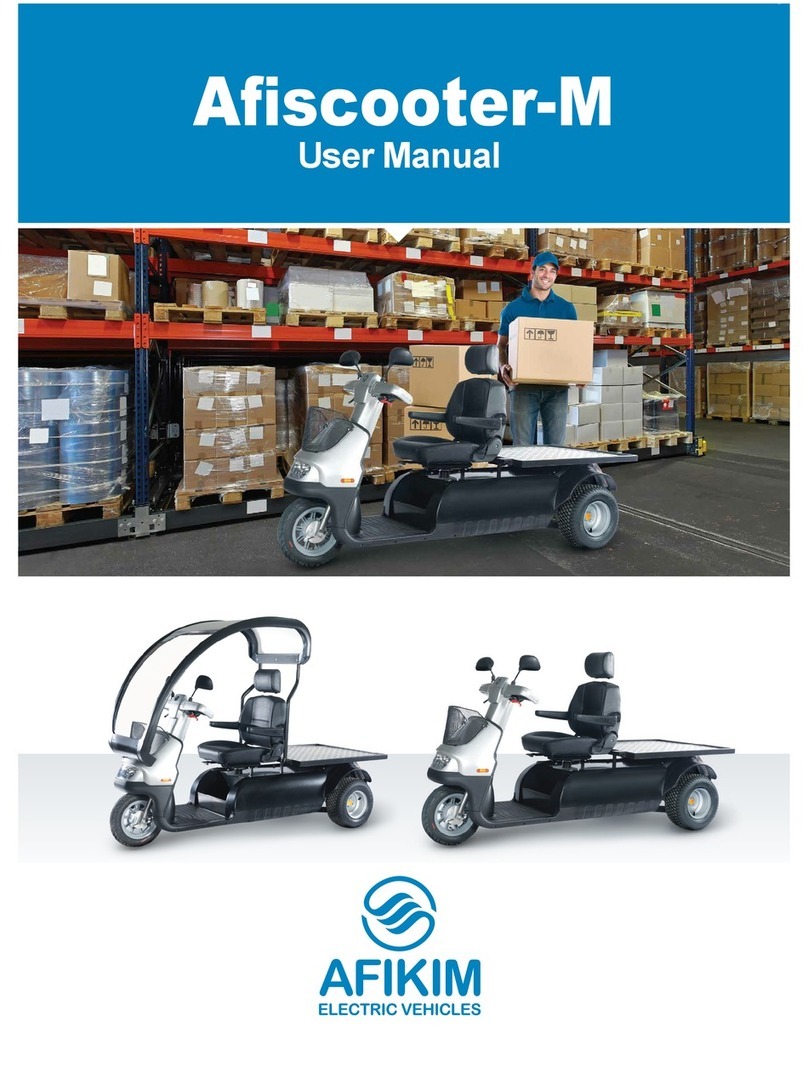
Afikim
Afikim Afiscooter-M User manual

Afikim
Afikim afiscooter-s User manual
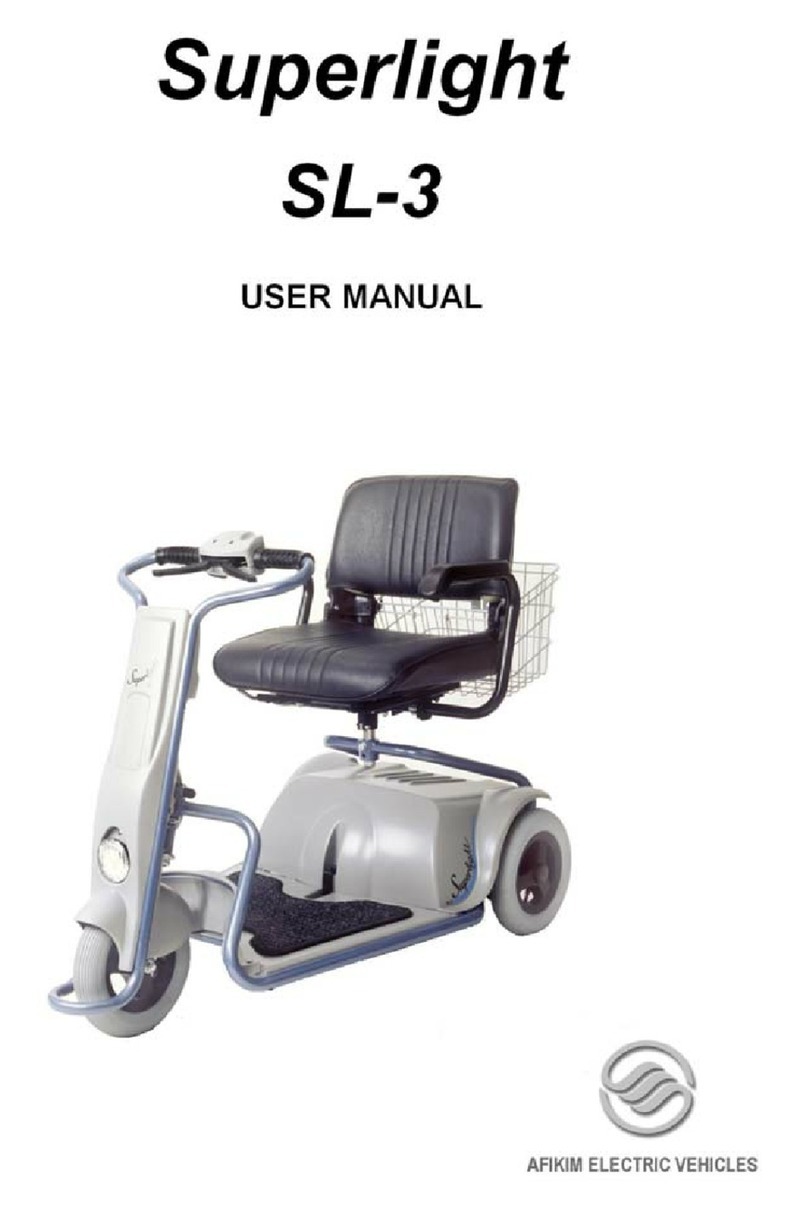
Afikim
Afikim Superlight SL-3 User manual

Afikim
Afikim Breeze C3 User manual
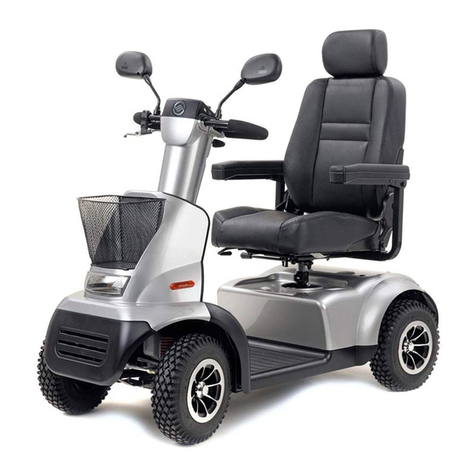
Afikim
Afikim Breeze-C User manual
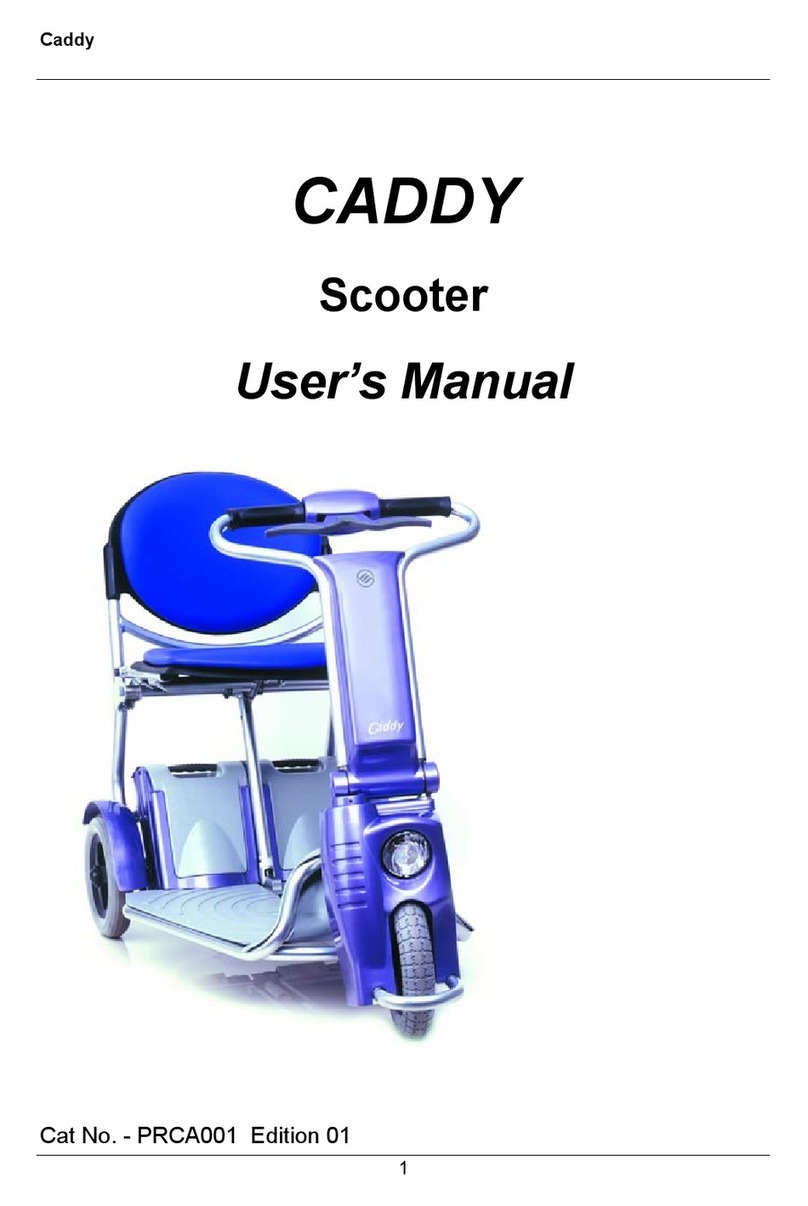
Afikim
Afikim Caddy User manual

Afikim
Afikim Breeze User manual
Popular Scooter manuals by other brands
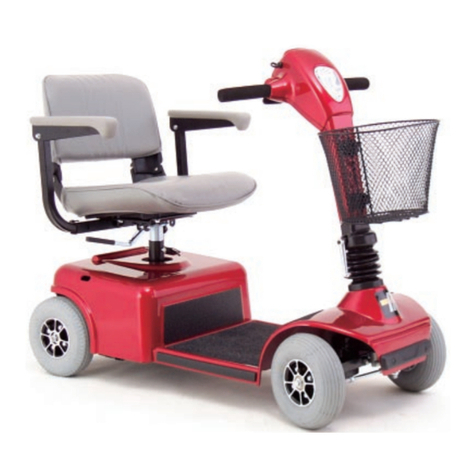
Pride Mobility
Pride Mobility scooter owner's manual

Dynacraft
Dynacraft MONSTER HIGH owner's manual
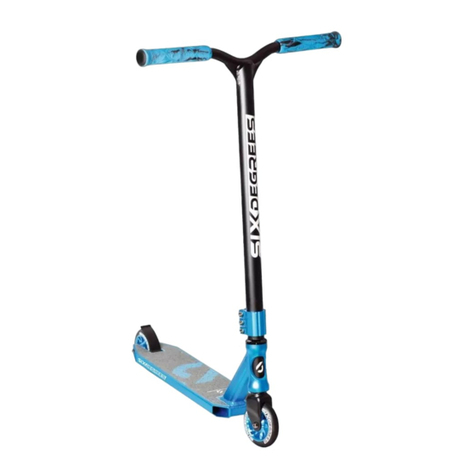
Authentic Sports & Toys
Authentic Sports & Toys SIX DEGREES Stuntscooter owner's manual
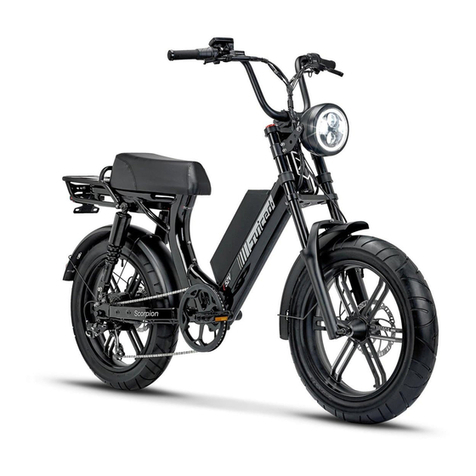
Juiced Bikes
Juiced Bikes SCORPION 2021 owner's manual

RA
RA GP125i Maintenance manual
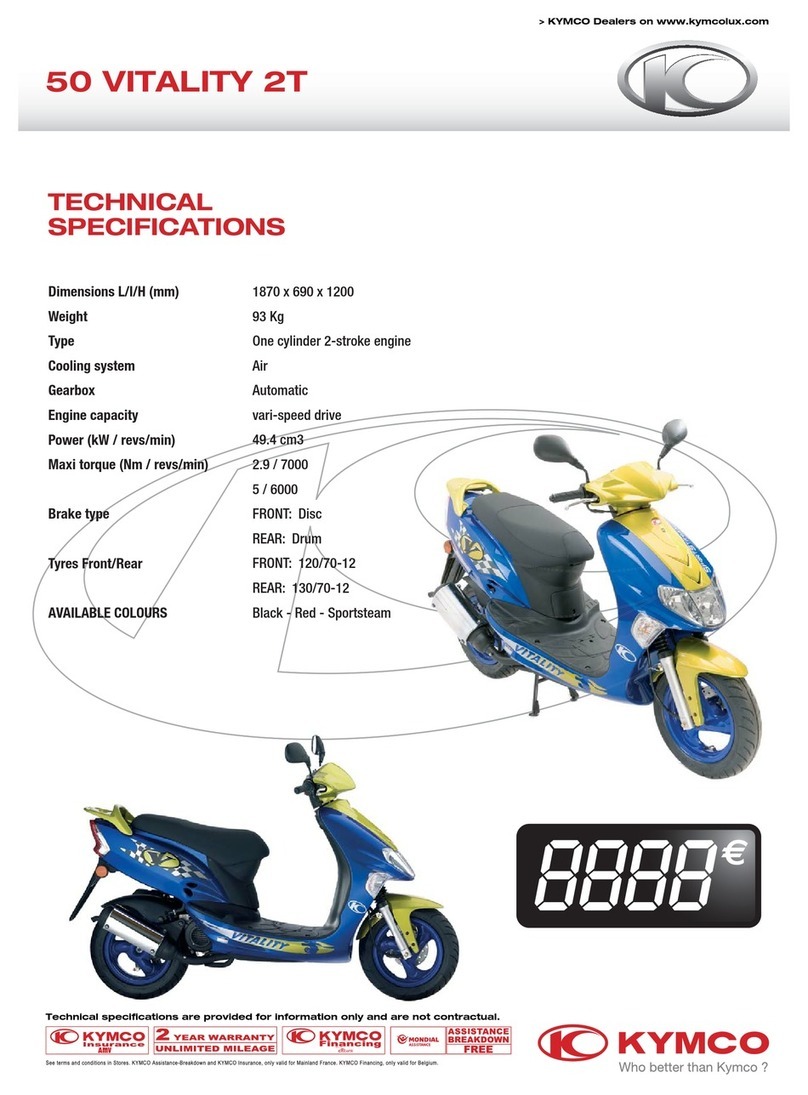
KYMCO
KYMCO 50 VITALITY 2T Specifications

